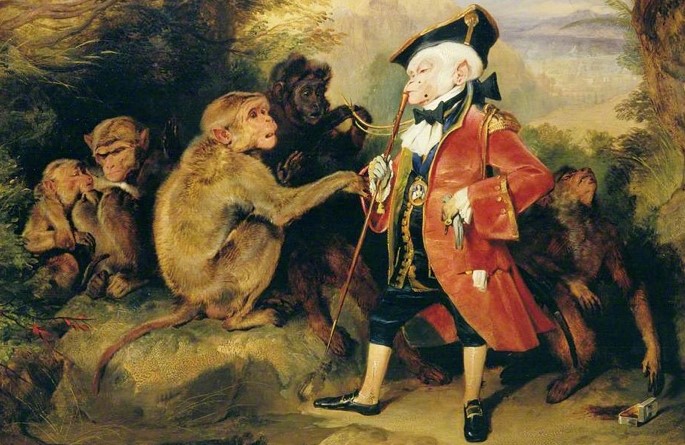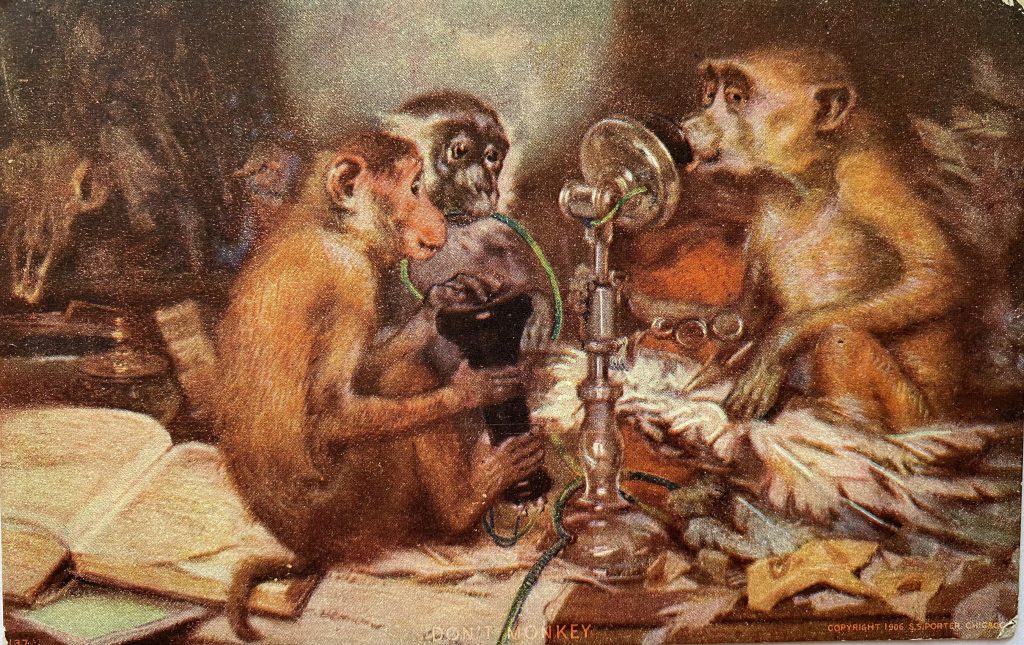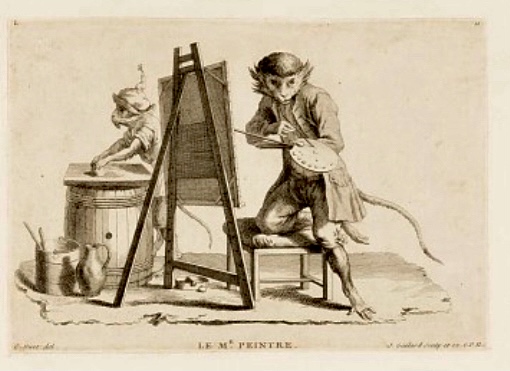Anne Ross
Don’t Monkey Around
with the Telephone!
Among the most entertaining postcards are those showing animals in human predicaments. A good example is the singerie by Sir Edwin Landseer of an Englishmen who traveled to France and came back aping the French in their dress and mannerisms.

Another is this one captioned Don’t Monkey. It features a painting of three monkeys behaving like humans in play with a telephone. The painting is by an unknown artist. On the simplest level, it’s an early 20th century equivalent of the silly pet videos on YouTube. On a deeper level, it’s a parody of society’s reaction to early telephones – with a moral message attached.

Collectors can classify this postcard as either an “anthropomorphic” card or as a “singerie.” Anthropomorphic cards show any species of animal acting as if they are people, but a singerie is more species-specific. Singerie is a French term for “monkey trick.” This genre first became popular in Dutch and French art during the 17th and 18th centuries. The most common singeries are quite satirical. They show monkeys dressed in human clothes, mimicking human behavior as if they desperately want to be human.
Although monkeys easily imitate people, their lack of reasoning means that they cannot comprehend their own actions. Primates are seen as lesser beings because they are our closest biological relatives, but they are still not human. Therefore, it was socially acceptable to use monkeys to make fun of human behavior. At their cruelest, singeries satirized our human obsession with new trends like telephones.
On this postcard, the monkey on the right is mimicking a human speaking into the telephone. He has dropped a pair of eyeglasses in order to grab the phone. The monkey on the left holds the receiver, listening but unsure what to do in response. He is sitting on a book, having attempted to read like a human – only to chew on the pages in frustration and give up! The grey-faced monkey in the center unwittingly plays saboteur, chewing on the telephone cord. He cannot understand that his actions may result in electric shock that would end any attempt to be more like a human!
Today, the monkeys’ antics make us laugh. But in 1906, this image was meant to poke fun at people’s awkward attempts to use early telephones and their reactions to the new technology.
For many years after 1876 when Alexander Graham Bell perfected his invention, the telephone was seen as a dangerous tool which explains this postcard’s title “Don’t Monkey.” People who bought telephones were seen as foolish. How could you make use of a telephone if the only other person you knew who had one was the operator? Rumors ran rampant about the newfangled contraption, generating fears that were both rational and irrational.
Fear kept many people from using the telephone even thirty years after it first appeared. Some feared being spied upon when using a party line. Others worried that listening to voices on the phone might cause mental illness. But the most common fear was that of being hit by lightning or being shocked while talking on the phone. Early phone company advertisements went to great lengths to reassure the public, while also promoting the magical convenience of the new apparatus. They conveyed the message that the telephone wasn’t a silly fad. It was here to stay!
Look closely and you’ll find that the telephone is not the only object in the image with hidden meanings. On the left, there’s an animal skull in the background. In still life paintings, this type of symbolic motif is a “memento mori.” Memento mori commonly appear in a genre of still life art known as “vanitas” paintings. Objects such as skulls, flowers, pocket watches, burnt-out candles, upended hourglasses, or empty oil lamps symbolize the fleeting nature of time. These details remind us of our mortality.

The skull warns us that life is short, so act wisely. The monkey chewing on the phone cord also reinforces this message: misuse a newfangled contraption called a telephone and you might end up dead!

The three monkeys warn us that going outside proper social norms can be dangerous. If the “lower orders” attempt to ape their betters, the result can be disastrous. Trying to be something you are not can get you in trouble! Don’t meddle with things you don’t understand. If you have a newfangled gadget to monkey around with; be careful what you wish for!
Thankyou. I knew of the term ‘Anthropomorphic’ although the more species-specific singerie is a new term for me. The suggestion that the telephone causes mental illness wasn’t confined to the introduction of the device as I recall the in the 1990s or so the suggestion that overuse of the mobile phone caused brain damage. I also live in an area where a neighbour sought to petition for the relocation of a lamppost sized telephone mast as it emitted harmful waves. Still these thoughts are in the past…although some people genuinely believe G5 networks and COVID are linked.
Landseer was also known for his painting “Stag at Bay”, which one of my professors of English used as an example of Victorian kitsch, the artistic equivalent of Edward Bulwer-Lytton’s novel Paul Clifford, whose opening words “It was a dark and stormy night” have been immortalized by Snoopy’s attempts at writing prose.
Interesting how the popularity of artistic genres and tastes change, isn’t it? Landseer’s other famous stag painting, the monarch of the Glen has become iconic of The Highlands. For years his work was sneered at. It could be said that one man is largely responsible for British art of the 1700-1800’s becoming more popular-Paul Mellon. He bought thousands of British paintings.
Such interesting facts.
Thank you!
I happen to have an antique Post Card with MONKEY playing music.
Can I post a picture of it?
I manage to post it, take a look.
From my collection.